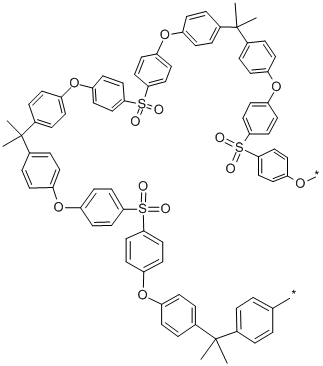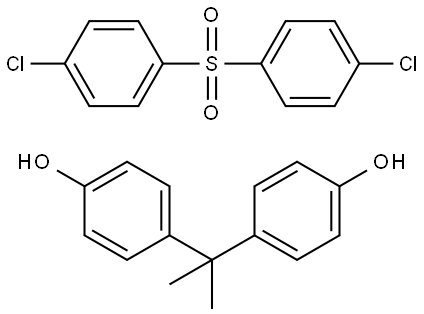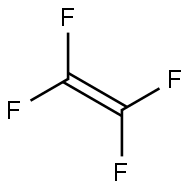POLYSULFONE
Synonym(s):SU341025;SU341100;SU341450;SU347930
- CAS NO.:25135-51-7
- Empirical Formula: C81H66O12S3X2
- Molecular Weight: 1327.58
- MDL number: MFCD00134387
- SAFETY DATA SHEET (SDS)
- Update Date: 2025-01-27 09:38:02

What is POLYSULFONE?
Description
Polysulfone (PSU) plastics comprise polysulfone [—Ph—C(CH3 )2 —Ph—O—Ph—SO2 —O—]n, polyester sulfone [—O—Ph—SO2 —O—]n and polyphenylsulfone [—O—Ph—SO2 —Ph— O—Ph—Ph—]n with the aryl radical Ph = C6 H4 . The isopropylidene linkage imparts chemical resistance, the ether bond imparts temperature resistance, while the sulfone linkage imparts impact strength. The brittleness temperature of polysulfones is –100°C. Polysulfones are clear, strong, nontoxic, and virtually unbreakable. However, stress cracking can be a problem and should be considered before use. PSU do not hydrolyze during autoclaving and they are resistant to acids, alkalis, aqueous solutions, aliphatic hydrocarbons, and alcohols. Hence they have added another dimension to thermoplastics in heat resistance and strength at high temperature. The ease of molding the material, and its retention of properties as temperatures increase, has made it one of the faster growing resins in the market place. Use of the product for chemical equipment applications has not been noted to date but is anticipated.
Chemical properties
transparent pellets
The Uses of POLYSULFONE
Microwave cookware, appliance covers, surgical tools, automotive electrical components, printed circuit boards and plumbing components.
Properties of POLYSULFONE
| Melting point: | 185 °C |
| Density | 1.24 g/mL at 25 °C(lit.) |
| refractive index | n |
| storage temp. | -20°C |
| form | pellets |
| color | Transparent |
Safety information for POLYSULFONE
| Signal word | Warning |
| Pictogram(s) |
 Exclamation Mark Irritant GHS07 |
| GHS Hazard Statements |
H302:Acute toxicity,oral H315:Skin corrosion/irritation H319:Serious eye damage/eye irritation H335:Specific target organ toxicity, single exposure;Respiratory tract irritation |
| Precautionary Statement Codes |
P261:Avoid breathing dust/fume/gas/mist/vapours/spray. P280:Wear protective gloves/protective clothing/eye protection/face protection. P301+P312:IF SWALLOWED: call a POISON CENTER or doctor/physician IF you feel unwell. P302+P352:IF ON SKIN: wash with plenty of soap and water. P305+P351+P338:IF IN EYES: Rinse cautiously with water for several minutes. Remove contact lenses, if present and easy to do. Continuerinsing. |
Computed Descriptors for POLYSULFONE
New Products
4,4-Difluoropiperidine hydrochloride tert-butyl 9-methoxy-3-azaspiro[5.5]undecane-3-carboxylate Indole Methyl Resin N-Isopropylurea N,N-Dicyclohexylcarbodiimide(DCC) MELDRUMS ACID 5-METHYLISOXAZOLE-4-CARBOXYLIC ACID Magnessium Bis glycinate Zinc ascorbate 1-bromo-2-butyne 2-acetamidophenol 9(10H)-anthracenone Erythrosin B, 4-Piperidinopiperidine 2-((4-morpholinophenylamino) (methylthio) methylene) malononitrile 2,4-dihydroxybenzaldehyde 3-(4-morpholinophenylamino)-5-amino-1H-pyrazole-4-carbonitrile Methyl 2-methylquinoline-6-carboxylate 2,6-dichloro-4-nitropyridine 4-Bromo-2-chlorobenzonitrile 2-(benzylamino)acetic acid hydrochloride 4-(tert-Butoxycarbonylamino)but- 2-ynoic acid 3,4-dihydro-2H-benzo[b][1,4]dioxepine 1-Phenyl-1-cycloprppanecarboxylicacidRelated products of tetrahydrofuran








You may like
-
 Polysulfone CASView Details
Polysulfone CASView Details -
 Polysulfone CASView Details
Polysulfone CASView Details -
 Polysulfone CASView Details
Polysulfone CASView Details -
 Polysulfone CASView Details
Polysulfone CASView Details -
 Polysulfone CASView Details
Polysulfone CASView Details -
 Polysulfone CASView Details
Polysulfone CASView Details -
 Polysulfone CASView Details
Polysulfone CASView Details -
 Polysulfone CASView Details
Polysulfone CASView Details
